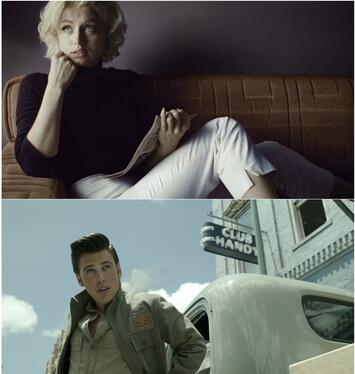
When Marilyn Monroe was cast as a spunky cannery worker in Clash by Night (1952), she took “an all-night bus to Monterey to observe cannery workers and to practice being working class.” As biographer Lois Banner noted, she was even offered a job, cutting off the heads of sardines. But Marilyn was already familiar with factory work. During the war, she worked at the Radio Plane Munitions factory, assembling drones and painting cloth fuselages with a toxic lacquer, a job that she later called “the hardest work I’d ever done.” In less than a decade she had gone from the airplane factory, to the dream factory, and, for a few hours, to the sardine factory.
While this particular episode is not featured in Netflix’s forthcoming Blonde, a daring adaption of Joyce Carol Oates’s fictionalized account of Marilyn’s life, the film reminds us that the star who epitomized Hollywood glamour had a broken childhood. Marilyn never knew her father, and from a young age she bounced between foster care, orphanages, and the homes of extended family members. Blonde director Andrew Dominik explains that the film is about “how a childhood trauma shapes an adult who’s split between a public and a private self.”
Blonde isn’t the only biopic out this year that traces the working-class roots of a major star. Baz Luhrmann’s Elvis, now streaming on HBO Max, draws on the director’s interviews with Elvis’s childhood friends, who remembered playing with Elvis among the shacks and revival tents in the poorest, Blackest neighborhoods in Tupelo, Mississippi. Elvis also lingers on the singer’s short career as a super cool looking truck driver.
It’s intriguing that two biopics of the 20th century’s most famous—and most working-class—superstars have appeared in 2022. Why? Do they reflect increased interest in workers as baristas, Amazon workers, teachers, railway workers, and many others are on the march? Perhaps. In addition, these films remind us that Marilyn and Elvis were progressives. Marilyn was a left-wing intellectual who, as one writer has pointed out, was more often photographed reading a book than posing naked. When she married Arthur Miller in 1956, FBI agents were concerned that Marilyn was “drifting into the Communist orbit.” In 1962, an FBI report described Marilyn’s views as “very positively and concisely leftist.”
Elvis was also progressive, especially when it came to race and civil rights. He was friends with B.B. King and other Black musicians who frequented Beale Street. Elvis was devastated by the murders of Martin Luther King and Bobby Kennedy, as the Luhrmann film suggests. And, according Nancy Isenberg, author of White Trash: The 400-Year Untold History of Class in America, Elvis supported President Johnson’s civil rights efforts.
It mattered that Elvis and Marilyn were working class. Elvis had a deep knowledge of folk, country, and rhythm and blues music because he had spent his life on the other side of the tracks, where poor whites and Blacks intermingled. This knowledge shaped the originality, and the popularity, of his sound. Likewise, Marilyn had a humility and a frankness that were key to her popularity. When it was discovered that Marilyn had posed nude early in her career, Marilyn weathered the scandal without incident. When she was asked why she did it, she replied simply that “I was broke and needed the money.”
Read the rest of this piece at Working Class Perspectives.
Kathy M. Newman is an Associate Professor of English at Carnegie Mellon University and author of Radio-Active: Advertising and Activism 1935-1947.
Photo: screens from Blonde and Elvis, courtesy Working Class Perspectives.












